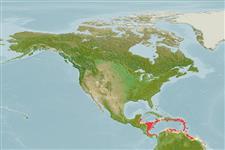Environment: milieu / Zona climática / intervalo de profundidade / distribution range
Ecologia
marinhas associadas(os) a recifes; intervalo de profundidade 0 - 66 m (Ref. 9710). Subtropical; 19°N - 1°S, 89°W - 48°W (Ref. 55171)
Western Atlantic: Bermuda, Florida Keys (USA), Gulf of Mexico, Bahamas; Greater Antilles (including Cuba, Hispanola, Puerto Rico, Jamaica and Cayman Is.), Virgin Is.; Lesser Antilles (island chain south of the British Virgin Islands to Grenada); western Caribbean (ne tip of the Yucatan Peninsula to Colombia, including offshore islands; northern South America (region north of Amazon River including Trinidad and Tobago and off coasts of Colombia, Venezuela. Eastern Atlantic: Ascension Island.
Tamanho / Peso / Idade
Maturidade: Lm ? range ? - ? cm
Max length : 20.0 cm TL macho/indeterminado; (Ref. 7251)
Descrição suscinta
Chaves de identificação | Morfologia | Morfometria
Raios dorsais (total) : 11 - 12; Raios anais : 6 - 7. Illicium about twice as long as second dorsal spine (Ref. 26938).
Body shape (shape guide): short and / or deep.
Inhabit shallow reefs (Ref. 9710). Commonly found in areas with sponges; background hue of the fish conforms to that of the dominant sponge in the areas and the ocelli look like openings in the sponge. Feed mainly on fishes, but also eat crustaceans (Ref. 13442). A voracious predator, with many color phases used for camouflage. Oviparous (Ref. 205). Eggs are bound in ribbon-like sheath or mass of gelatinous mucus called 'egg raft' or 'veil' (Ref. 6773). Most common frogfish in the West Indies (Ref. 26938).
Ciclo de vida ou comportamento de acasalamento
Maturidade | Reprodução | Desova | Ovos | Fecundidade | Larvas
Oviparous.
Robins, C.R. and G.C. Ray, 1986. A field guide to Atlantic coast fishes of North America. Houghton Mifflin Company, Boston, U.S.A. 354 p. (Ref. 7251)
Status na Lista Vermelha da UICN (Ref. 130435: Version 2025-1)
Ameaça para os humanos
Harmless
Uso pelos humanos
Pescarias: pesca de subsistência; Aquário: Espécies comerciais
Ferramentas
Relatórios especiais
Baixar XML
Fontes da internet
Estimates based on models
Preferred temperature (Ref.
123201): 27.1 - 28.3, mean 27.8 °C (based on 78 cells).
Índice de diversidade filogenética (Ref.
82804): PD
50 = 0.5002 [Uniqueness, from 0.5 = low to 2.0 = high].
Bayesian length-weight: a=0.02630 (0.01029 - 0.06725), b=2.96 (2.73 - 3.19), in cm total length, based on LWR estimates for this (Sub)family-body shape (Ref.
93245).
Nível Trófico (Ref.
69278): 4.3 ±0.7 se; based on diet studies.
Resiliência (Ref.
120179): Elevada, tempo mínimo de duplicação da população menor que 15 meses (Fec assumed to be > 10,000).
Fishing Vulnerability (Ref.
59153): Low vulnerability (10 of 100).
🛈
Nutrients (Ref.
124155): Calcium = 33.2 [14.6, 80.1] mg/100g; Iron = 0.619 [0.309, 1.196] mg/100g; Protein = 19.5 [17.0, 22.7] %; Omega3 = 0.182 [0.066, 0.484] g/100g; Selenium = 12.3 [4.9, 32.9] μg/100g; VitaminA = 114 [27, 508] μg/100g; Zinc = 0.686 [0.399, 1.116] mg/100g (wet weight);
